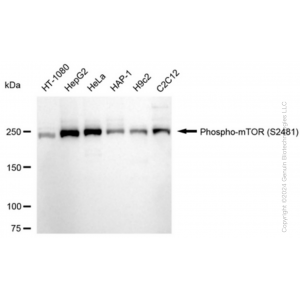| Reactivity: | Human, Mouse, Rat |
| Applications: | WB, FC, IC |
| Host Species: | Rabbit |
| Isotype: | IgG |
| Clonality: | Monoclonal antibody |
| Gene Name: | mechanistic target of rapamycin kinase |
| Gene Symbol: | MTOR |
| Synonyms: | SKS; FRAP; FRAP1; FRAP2; RAFT1; RAPT1 |
| Gene ID: | 2475 |
| UniProt ID: | P42345 |
| Clone ID: | 24GB325 |
| Immunogen: | A synthesized peptide derived from human Phospho-mTOR (S2481) |
| Dilution: | WB 1:1,000-1:5,000; FC 1:2,000; IC 1:100-1:1,000 |
| Purification Method: | Affinity purified |
| Concentration: | Lot dependent |
| Buffer: | PBS with 0.02% sodium azide, 50% glycerol, pH7.3. |
| Storage: | Store at -20°C. Avoid freeze/thaw cycles. |
Background
The protein encoded by the gene MTOR belongs to a family of phosphatidylinositol kinase-related kinases. These kinases mediate cellular responses to stresses such as DNA damage and nutrient deprivation. This kinase is a component of two distinct complexes, mTORC1, which controls protein synthesis, cell growth and proliferation, and mTORC2, which is a regulator of the actin cytoskeleton, and promotes cell survival and cell cycle progression. This protein acts as the target for the cell-cycle arrest and immunosuppressive effects of the FKBP12-rapamycin complex. Inhibitors of mTOR are used in organ transplants as immunosuppressants, and are being evaluated for their therapeutic potential in SARS-CoV-2 infections. Mutations in this gene are associated with Smith-Kingsmore syndrome and somatic focal cortical dysplasia type II. The ANGPTL7 gene is located in an intron of this gene.
Images
 | Western blotting analysis using anti-Phospho-mTOR (S2481) antibody (Cat#62329). Total cell lysates (30 μg) from various cell lines were loaded and separated by SDS-PAGE. The blot was incubated with anti-Phospho-mTOR (S2481) antibody (Cat#62329, 1:5,000) and HRP-conjugated goat anti-rabbit secondary antibody (Cat#201, 1:20,000) respectively. Image was developed using FeQ™ ECL Substrate Kit (Cat#226). |
 | Western blotting analysis using anti-Phospho-mTOR (S2481) antibody (Cat#62329). Phospho-mTOR (S2481) expression in wild type (WT) and Phospho-mTOR (S2481) shRNA knockdown (KD) HeLa cells with 20 μg of total cell lysates. Hsp90 α serves as a loading control. The blot was incubated with anti-Phospho-mTOR (S2481) antibody (Cat#62329, 1:5,000) and HRP-conjugated goat anti-rabbit secondary antibody (Cat#201, 1:20,000) respectively. Image was developed using NaQ™ ECL Substrate Kit (Cat#716). |
 | Flow cytometric analysis of Phospho-mTOR (S2481) expression in HepG2 cells using Phospho-mTOR (S2481) antibody (Cat#62329, 1:2,000). Green, isotype control; red, Phospho-mTOR (S2481). |
 | Immunocytochemical staining of HepG2 cells with anti-Phospho-mTOR (S2481) antibody (Cat#62329, 1:1,000). Nuclei were stained blue with DAPI; Phospho-mTOR (S2481) was stained magenta with Alexa Fluor® 647. Images were taken using Leica stellaris 5. Protein abundance based on laser Intensity and smart gain: High. Scale bar: 20 μm. |
You may also be interested in:

